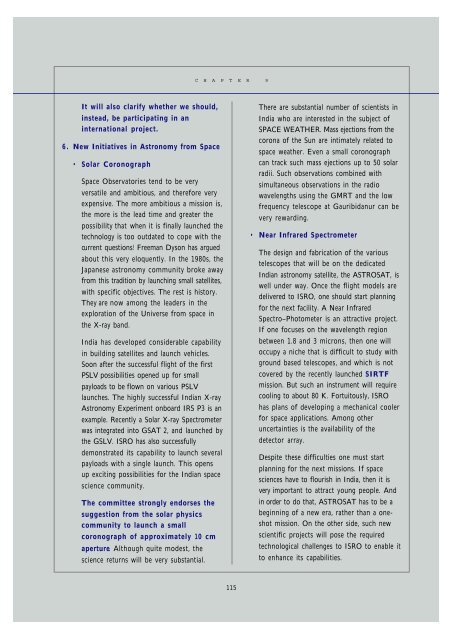2004 ASTRONOMY & ASTROPHYSICS - Indian Academy of Sciences
2004 ASTRONOMY & ASTROPHYSICS - Indian Academy of Sciences
2004 ASTRONOMY & ASTROPHYSICS - Indian Academy of Sciences
You also want an ePaper? Increase the reach of your titles
YUMPU automatically turns print PDFs into web optimized ePapers that Google loves.
CHAPTER 9<br />
It will also clarify whether we should,<br />
instead, be participating in an<br />
international project.<br />
6. New Initiatives in Astronomy from Space<br />
• Solar Coronograph<br />
Space Observatories tend to be very<br />
versatile and ambitious, and therefore very<br />
expensive. The more ambitious a mission is,<br />
the more is the lead time and greater the<br />
possibility that when it is finally launched the<br />
technology is too outdated to cope with the<br />
current questions! Freeman Dyson has argued<br />
about this very eloquently. In the 1980s, the<br />
Japanese astronomy community broke away<br />
from this tradition by launching small satellites,<br />
with specific objectives. The rest is history.<br />
They are now among the leaders in the<br />
exploration <strong>of</strong> the Universe from space in<br />
the X-ray band.<br />
India has developed considerable capability<br />
in building satellites and launch vehicles.<br />
Soon after the successful flight <strong>of</strong> the first<br />
PSLV possibilities opened up for small<br />
payloads to be flown on various PSLV<br />
launches. The highly successful <strong>Indian</strong> X-ray<br />
Astronomy Experiment onboard IRS P3 is an<br />
example. Recently a Solar X-ray Spectrometer<br />
was integrated into GSAT 2, and launched by<br />
the GSLV. ISRO has also successfully<br />
demonstrated its capability to launch several<br />
payloads with a single launch. This opens<br />
up exciting possibilities for the <strong>Indian</strong> space<br />
science community.<br />
The committee strongly endorses the<br />
suggestion from the solar physics<br />
community to launch a small<br />
coronograph <strong>of</strong> approximately 10 cm<br />
aperture. Although quite modest, the<br />
science returns will be very substantial.<br />
There are substantial number <strong>of</strong> scientists in<br />
India who are interested in the subject <strong>of</strong><br />
SPACE WEATHER. Mass ejections from the<br />
corona <strong>of</strong> the Sun are intimately related to<br />
space weather. Even a small coronograph<br />
can track such mass ejections up to 50 solar<br />
radii. Such observations combined with<br />
simultaneous observations in the radio<br />
wavelengths using the GMRT and the low<br />
frequency telescope at Gauribidanur can be<br />
very rewarding.<br />
• Near Infrared Spectrometer<br />
The design and fabrication <strong>of</strong> the various<br />
telescopes that will be on the dedicated<br />
<strong>Indian</strong> astronomy satellite, the ASTROSAT, is<br />
well under way. Once the flight models are<br />
delivered to ISRO, one should start planning<br />
for the next facility. A Near Infrared<br />
Spectro–Photometer is an attractive project.<br />
If one focuses on the wavelength region<br />
between 1.8 and 3 microns, then one will<br />
occupy a niche that is difficult to study with<br />
ground based telescopes, and which is not<br />
covered by the recently launched SIRTF<br />
mission. But such an instrument will require<br />
cooling to about 80 K. Fortuitously, ISRO<br />
has plans <strong>of</strong> developing a mechanical cooler<br />
for space applications. Among other<br />
uncertainties is the availability <strong>of</strong> the<br />
detector array.<br />
Despite these difficulties one must start<br />
planning for the next missions. If space<br />
sciences have to flourish in India, then it is<br />
very important to attract young people. And<br />
in order to do that, ASTROSAT has to be a<br />
beginning <strong>of</strong> a new era, rather than a oneshot<br />
mission. On the other side, such new<br />
scientific projects will pose the required<br />
technological challenges to ISRO to enable it<br />
to enhance its capabilities.<br />
115
















